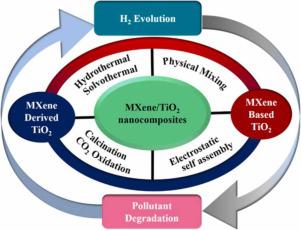Journal of Environmental Chemical Engineering ( IF 7.7 ) Pub Date : 2022-01-21 , DOI: 10.1016/j.jece.2022.107211 Lijarani Biswal 1 , Ritik Mohanty 1 , Susanginee Nayak 1 , Kulamani Parida 1

|
MXenes have grabbed considerable research attention in photocatalytic field owing to their regular planer structure, elemental composition, excellent metal conductivity, surface termination groups and abundant derivatives. MXene-derived and based materials deliver motivation for fabrication of novel photocatalysts with optimum activity, and long term stability. Meanwhile, TiO2 being the most extensively studied photocatalyst for solar light driven water splitting and environmental remediation, owing to its noble photocatalytic activity, low cost, nontoxicity, and copious availability. Nevertheless, the major drawbacks of TiO2 based systems are its ultra-wide band gap and rapid recombination of photoinduced charge carriers. In this context, MXene have been rigorously explored for the modification of TiO2 which includes the MXene derived TiO2 (in-situ derived TiO2 from MXene) and MXene/TiO2 based nanocomposite (externally added TiO2 with MXene) for easy channelization of electrons owing to the metal-semiconductor contact where MXene can behave as a co-catalyst or support by enhancing the overall activity. Although a few reviews have been published highlighting the synthesis, inherent properties and applications in various fields, but this particular review highlights the recent advances of the adopted synthetic routes to develop MXene-derived TiO2 and MXene/TiO2 based nanocomposite, explaining the mechanism of charge carrier separation due to the formation of schottky junction at the interface of electrically conductive Ti3C2 and optically active TiO2 for achieving outstanding photocatalytic hydrogen (H2) evolution and pollutant degradation. Furthermore, the future challenges including the materials design process and to improve the overall activity for the promotion of MXenes derivative and allied materials has been proposed with correlating the structural features and activity.
中文翻译:

用于光催化制氢和污染物降解的 MXene/TiO2 纳米杂化物综述
MXenes由于其规则的平面结构、元素组成、优异的金属导电性、表面末端基团和丰富的衍生物而在光催化领域引起了广泛的研究关注。MXene 衍生和基于材料的材料为制造具有最佳活性和长期稳定性的新型光催化剂提供了动力。同时,由于其高光催化活性、低成本、无毒和丰富的可用性,TiO 2是用于太阳能光驱动水分解和环境修复的最广泛研究的光催化剂。然而,TiO 2的主要缺点基于系统的系统是其超宽带隙和光致电荷载流子的快速复合。在此背景下,MXene 对 TiO 2的改性进行了严格的探索,其中包括 MXene 衍生的 TiO 2(来自 MXene 的原位衍生的 TiO 2)和基于 MXene/TiO 2的纳米复合材料(外部添加的 TiO 2由于金属-半导体接触,MXene 可以轻松实现电子通道化,其中 MXene 可以通过提高整体活性来充当助催化剂或载体。尽管已经发表了一些综述,重点介绍了合成、固有特性和在各个领域的应用,但这篇特别的综述强调了采用合成路线开发 MXene 衍生的 TiO 2和 MXene/TiO 2基纳米复合材料的最新进展,解释了机理由于在导电 Ti 3 C 2和光学活性 TiO 2的界面处形成肖特基结,电荷载流子分离,以实现出色的光催化氢(H 2) 演变和污染物降解。此外,还提出了未来的挑战,包括材料设计过程和提高整体活性以促进 MXenes 衍生物和相关材料的相关性,并与结构特征和活性相关联。

























 京公网安备 11010802027423号
京公网安备 11010802027423号